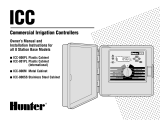8
using drip irrigation could run on a separate program once every two weeks.
The garden area requirements might include watering every other day.
To take full advantage of the programming options available, it is
important to first understand how the controller works during operation.
The following section explains what a watering cycle is and provides a
basic example of how multiple programs can be set up.
WHAT IS A PROGRAM WATERING CYCLE?
When a watering start time is selected, that time becomes the beginning
of an automatic watering cycle. A watering cycle operates each station
assigned to the program, one by one, in numerical order.
In the following example (also shown on the sample watering plan on
page 9), we have set up Program A to start at 2: 00 a.m. and again at
3:00 a.m. on a 1-day interval (every day). Stations 1, 2, 4 and 5 are front
and back yard lawn areas which get full sun throughout the day. Each
station will run for 10 minutes per watering cycle, for a total of 20
minutes run time per day. Stations 3, 6 and 7 are lawn areas which are
shaded during the afternoon hours. These areas require less water, so we
have assigned them to Program B and programmed them to run once for
20 minutes on a 2-day interval (every other day).
At 2:00 a.m., Program A watering cycle starts. Station 1 turns on, runs for
10 minutes, and shuts off. Station 2 turns on, runs for 10 minutes, and
turns off. Stations 4 and 5 operate sequentially in the same manner, each
running for their set run time. When Station 5 shuts off, the watering
cycle is completed for the first start time. At 3:00 a.m., the watering cycle
starts again and repeats the same station-by-station watering sequence.
Note that we have 40 minutes total operating time per cycle in
Program A. If we had set the next start time at 2:30 a.m., the start time
would have been delayed until 2:40 a.m., enabling the first cycle to finish
as programmed. This function is called “start time stacking”, and can
occur within each program.
Watering programs, however, operate independently, which means that
two or more programs can run simultaneously. In our example,
Program B will also start at 2:00 a.m. Therefore, Stations 1 and 3 will
turn on at the same time, and Station 2 will turn on while Station 3 is
running. This feature enables more watering to be completed within the
prime “watering window”, which is generally between Midnight and
6:00 a.m.
Note: When scheduling watering programs to run simultaneously, it is
important to ensure the water supply has sufficient pressure and volume
to maintain optimum sprinkler performance.
Programming the Controller





















